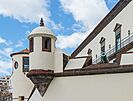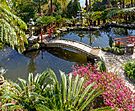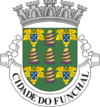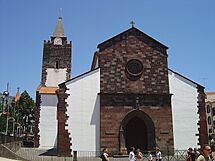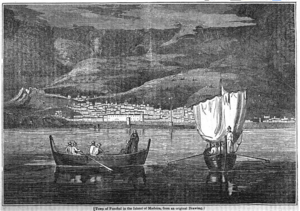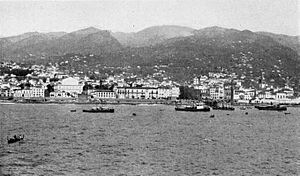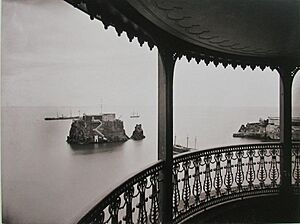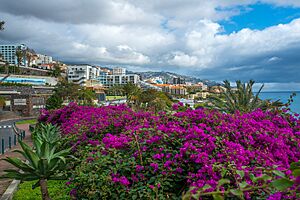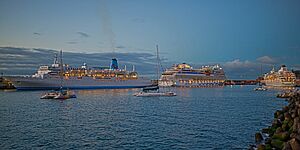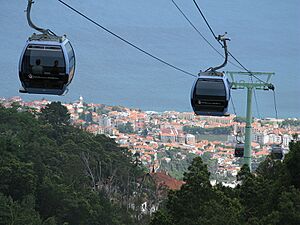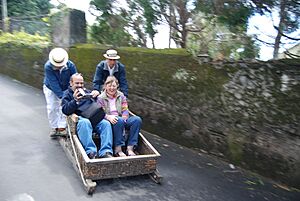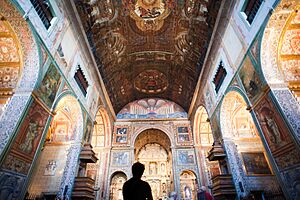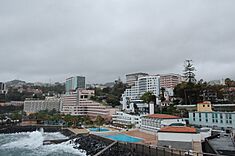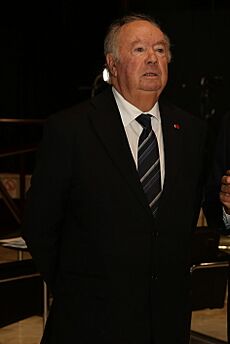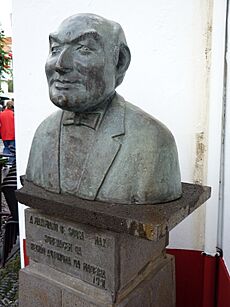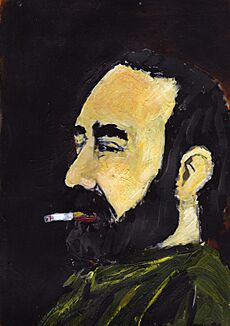Funchal facts for kids
Quick facts for kids
Funchal
|
|||
|---|---|---|---|
|
Municipality
|
|||
|
Funchal City Hall
Saint Lawrence's Palace
Madeira Botanical Garden
Funchal Cathedral
Monte Palace Tropical Garden
|
|||
|
|||

Location in Madeira
|
|||
| Country | |||
| Region | Madeira | ||
| Established | Settlement: (Catalan) 1424 Town: (Catalan) 1452–1454 Municipality: (Catalan) 1508 |
||
| Parishes | 10 | ||
| Area | |||
| • Total | 76.15 km2 (29.40 sq mi) | ||
| Population
(2021)
|
|||
| • Total | 105,795 | ||
| • Density | 1,389.30/km2 (3,598.26/sq mi) | ||
| Time zone | WET/WEST (UTC+0/+1) | ||
| Postal code |
9000
|
||
| Area code | 291 | ||
Funchal is the capital city of Portugal's Autonomous Region of Madeira. It's located right by the Atlantic Ocean. With about 105,795 people, it's one of the biggest cities in Portugal.
Funchal is a very important place for tourists. People love to visit because of its rich history and culture. It's also a popular spot for New Year's Eve celebrations and a top port for cruise liners.
Contents
What's in a Name?
The first people who settled here named the place Funchal. This was because of the many wild fennel plants growing everywhere. The name comes from the Portuguese word for fennel, funcho. The ending -al means "a place where something grows a lot."
A writer from the 1500s, Gaspar Frutuoso, said:
Funchal, to whom the captain gave this name, because it was founded in a beautiful forested valley, full of fennel up to the sea ...
—Gaspar Frutuoso, 16th century, As Saudades da Terra
A Look Back: Funchal's History
Funchal started as a small settlement around 1424. This was when the island of Madeira was divided into two areas called captaincies. João Gonçalves Zarco and his family were among the first to settle in the area that became Funchal. Its great location by the sea made it an important port. The fertile land also attracted many new settlers.
In the early 1400s, Álvaro Fernandes became the leader of Funchal. Between 1452 and 1454, Funchal became an official town and a local government center. It grew into a key trading spot for European businesses. Even Christopher Columbus lived here for a while! Many merchant families from different countries also moved to the island to trade.
By the late 1400s, the sugar industry grew a lot along the southern coast. Funchal became the main center for this industry. King Manuel I of Portugal helped the town grow even more. He ordered new buildings like the city hall and a church. This church later became a cathedral in 1514. In 1508, King Manuel I made Funchal a city.
Funchal was sometimes attacked by privateers and pirates. In 1566, French pirates attacked the city. They looted Funchal for fifteen days, causing a lot of damage. After this, a military architect named Mateus Fernandes III was sent to rebuild the city's defenses. His plan from 1573 is the oldest map of Funchal.
During the 1500s, Funchal was a vital stop for ships called caravels. These ships traveled between the Indies and the New World.
The island started growing grapes for wine very early on. By 1455, a traveler named Alvise Cadamosto praised Madeira's wines. He especially liked the Malvasia grapes. Even the famous English writer William Shakespeare mentioned Madeira wine in his plays!
The wine industry grew even more when sugar from other parts of the world became cheaper. Many English wine merchants moved to the island. This changed the economy, buildings, and way of life in Funchal. New homes and businesses were built. Even convents and governors got involved in the wine trade. However, in the 1800s, plant diseases hurt the wine industry. People tried to plant new types of grapes to keep the business going.
Many famous people have visited Funchal over the years. These include Elisabeth of Bavaria, the empress of Austria-Hungary, and Charles I of Austria, an exiled emperor. Winston Churchill also visited for holidays and painted here. These visits helped Funchal become a popular place for tourism and health retreats. With a modern port and airport, Funchal is now a big international tourist spot with many hotels.
Funchal's Location and Climate
Where is Funchal?
Funchal is built in a natural valley shaped like an amphitheatre. The land gently slopes up from the coast to about 1200 meters high. This natural shape protected the early settlers.
The municipality of Funchal also includes the Ilhas Selvagens (which means Savage Islands). These are a nature reserve located about 294 kilometers south of the city.
Funchal's Weather
Funchal has a warm, sunny climate. It's one of the warmest cities in Portugal, with an average yearly temperature of about 20.1°C (68.2°F).
The year has two main seasons:
- A warm, dry summer from May to September. Daily high temperatures are usually between 22°C (72°F) and 26°C (79°F).
- A cooler, wetter winter from October to April. Daily high temperatures are usually between 20°C (68°F) and 25°C (77°F).
The city always has warm temperatures, and it's quite humid, around 70%. The sea water is also warm, from 18°C (64°F) in winter to 24°C (75°F) in late summer.
Because the city goes from sea level up to 800 meters high, the weather can change. The northern parts, higher up, might be cloudy or rainy. But at the same time, the southern parts by the sea can have clear skies. Temperatures are also a bit cooler at higher altitudes.
In early summer, especially June, Funchal sometimes gets a lot of clouds covering the bay. Locals call this "Funchal's helmet."
| Climate data for Funchal Observatory, 1991–2020 (extremes 1961-2020), altitude: 58 m (190 ft) | |||||||||||||
|---|---|---|---|---|---|---|---|---|---|---|---|---|---|
| Month | Jan | Feb | Mar | Apr | May | Jun | Jul | Aug | Sep | Oct | Nov | Dec | Year |
| Record high °C (°F) | 25.5 (77.9) |
27.0 (80.6) |
30.5 (86.9) |
32.6 (90.7) |
34.2 (93.6) |
34.7 (94.5) |
37.7 (99.9) |
38.5 (101.3) |
38.4 (101.1) |
34.1 (93.4) |
29.5 (85.1) |
26.5 (79.7) |
38.5 (101.3) |
| Mean maximum °C (°F) | 21.8 (71.2) |
21.8 (71.2) |
23.2 (73.8) |
24.1 (75.4) |
25.7 (78.3) |
27.5 (81.5) |
29.7 (85.5) |
29.6 (85.3) |
28.8 (83.8) |
27.4 (81.3) |
24.8 (76.6) |
22.8 (73.0) |
31.6 (88.9) |
| Mean daily maximum °C (°F) | 19.8 (67.6) |
19.8 (67.6) |
20.4 (68.7) |
20.9 (69.6) |
22.1 (71.8) |
23.8 (74.8) |
25.6 (78.1) |
26.8 (80.2) |
26.5 (79.7) |
25.1 (77.2) |
22.6 (72.7) |
20.8 (69.4) |
22.8 (73.1) |
| Daily mean °C (°F) | 17.2 (63.0) |
17.0 (62.6) |
17.5 (63.5) |
18.0 (64.4) |
19.2 (66.6) |
21.1 (70.0) |
22.7 (72.9) |
23.9 (75.0) |
23.6 (74.5) |
22.2 (72.0) |
19.9 (67.8) |
18.3 (64.9) |
20.1 (68.1) |
| Mean daily minimum °C (°F) | 14.6 (58.3) |
14.1 (57.4) |
14.5 (58.1) |
15.1 (59.2) |
16.3 (61.3) |
18.3 (64.9) |
19.8 (67.6) |
20.9 (69.6) |
20.6 (69.1) |
19.3 (66.7) |
17.2 (63.0) |
15.7 (60.3) |
17.2 (63.0) |
| Mean minimum °C (°F) | 11.6 (52.9) |
11.3 (52.3) |
11.3 (52.3) |
12.4 (54.3) |
13.6 (56.5) |
15.9 (60.6) |
17.4 (63.3) |
18.7 (65.7) |
18.5 (65.3) |
16.2 (61.2) |
13.6 (56.5) |
12.8 (55.0) |
10.3 (50.5) |
| Record low °C (°F) | 8.2 (46.8) |
7.4 (45.3) |
7.7 (45.9) |
9.3 (48.7) |
9.7 (49.5) |
12.0 (53.6) |
14.6 (58.3) |
16.3 (61.3) |
14.9 (58.8) |
13.1 (55.6) |
9.8 (49.6) |
8.0 (46.4) |
7.4 (45.3) |
| Average precipitation mm (inches) | 98.7 (3.89) |
95.0 (3.74) |
83.4 (3.28) |
61.8 (2.43) |
44.5 (1.75) |
16.8 (0.66) |
3.7 (0.15) |
4.0 (0.16) |
44.9 (1.77) |
117.9 (4.64) |
111.7 (4.40) |
135.3 (5.33) |
817.7 (32.2) |
| Average precipitation days (≥ 1 mm) | 9.2 | 8.3 | 9.6 | 6.6 | 5.2 | 2.4 | 0.9 | 1.4 | 5.1 | 9.7 | 10.5 | 12.0 | 80.9 |
| Average relative humidity (%) | 71 | 70 | 68 | 68 | 70 | 73 | 73 | 72 | 71 | 71 | 70 | 70 | 71 |
| Mean monthly sunshine hours | 161 | 167 | 198 | 195 | 209 | 194 | 233 | 237 | 211 | 194 | 166 | 151 | 2,316 |
| Average ultraviolet index | 4.0 | 5.9 | 8.0 | 9.7 | 10.4 | 11.0 | 10.8 | 10.1 | 8.6 | 7.2 | 4.7 | 3.4 | 7.8 |
| Source 1: Météo Climat Infoclimat (average daily max UV recorded in 2015-2020) | |||||||||||||
| Source 2: NOAA (humidity 1961–1990), German Meteorological Service (sunshine 1991-2020) | |||||||||||||
Funchal's Communities
{{wide image|Funchal at Sunset.jpg|900px|A beautiful view of Funchal Bay at sunset.]]
The city of Funchal is part of a larger urban area. This area includes nearby towns like Câmara de Lobos and Santa Cruz. About 150,000 people live in this wider urban zone. Funchal itself is a lively city with parks, shops, and hotels.
The municipality (which is like a county) of Funchal is made up of ten smaller areas called civil parishes. These parishes are based on older religious districts. Here are some of them:
- Imaculado Coração de Maria – A northern area with many residents.
- Monte – Once a summer escape for rich people because of its nice weather. It's famous for its toboggan rides that take tourists down to the city.
- Santa Luzia – One of Funchal's city areas, growing into the hills.
- Santa Maria Maior – One of the first communities to develop along the coast.
- Santo António – The most populated parish, with about 22,000 people.
- São Gonçalo – Named after an early explorer.
- São Martinho – A very city-like area with about 20,000 people. It includes the hotel zone called Lido.
- São Pedro – A central area for businesses and homes.
- São Roque – Created from parts of other parishes.
- Sé – The historic heart of Funchal, with many old buildings.
Getting Around Funchal
Madeira Airport, also known as Funchal Airport or officially Cristiano Ronaldo International Airport, is east of the city. It used to be one of the trickiest airports because of cliffs. But now, the runway has been extended over the sea, making it much safer.
The Port of Funchal is Madeira's main port. Since 2007, it's only used for passenger ships like cruise ships and ferries. Fishing and cargo ships now use a newer port in Caniçal, about 12 miles (19 km) to the east.
A ferry service used to connect Funchal to Portimão on the mainland. It stopped for a while but started again in summer 2018. This ferry trip takes about 24 hours. There's also a ferry called the Lobo Marinho that takes two hours to get to Porto Santo Island.
Funchal is a common stop for ships crossing the Atlantic Ocean. It's on the route from Europe to the Caribbean. A highway connects Funchal to other towns on the island.
Fun Things to Do in Funchal
Funchal is a big tourist city. It has many hotels, a busy port, and the international airport.
Besides Funchal itself, other fun places to visit nearby include:
- Ribeira Brava
- Curral das Freiras
- Porto Moniz
- Santana
- The Laurisilva forest, a UNESCO Natural Site in the center of Madeira Island.
- The beaches on Porto Santo island.
You can also ride a gondola lift (the Funchal Cable Car). It takes people from the city center up to the suburb of Monte. Another cable car goes between Monte and the Botanical Gardens.
Museums to Explore
Funchal has many interesting museums:
- Casa-Museu Frederico de Freitas
- Núcleo Museológico da Cidade do Açúcar (Sugar City Museum)
- Museu Barbeito
- Museu CR7 (dedicated to Cristiano Ronaldo)
- Museu de Electricidade (Museum of Electricity)
- Museu de Arte Contemporânea do Funchal (Contemporary Art Museum)
- Sacred Art Museum of Funchal
- Museu de Fotografia – Vicentes (Photography Museum)
- Museu do Forte de S. Tiago (Fortress Museum)
- Museu do Vinho da Madeira (Madeira Wine Museum)
- Museu Henrique e Francisco Franco
- Museu de História Natural do Funchal (Natural History Museum)
- Museu Quinta das Cruzes
- Museu Sala de Troféus do Clube Sport Marítimo (Sports Trophy Museum)
- Núcleo Museológico do IVBAM
- Núcleo Museológico do Museu Militar Palácio São Lourenço (Military Museum)
- Núcleo Museológico Mary Jane Wilson
Faith and Community
Funchal is home to the main church (called a diocese) for the Roman Catholic bishop of Madeira. The main church is the Sé Cathedral. It is dedicated to Nossa Senhora da Assunção (Our Lady of the Assumption). Its patron saint is Saint James.
Anglican (Protestant) church services have been held in Funchal since 1822 at Holy Trinity Church. The Holy Trinity Church also looks after the British Cemetery of Funchal.
Funchal Baptist Church started in 1976. It offers services in both English and Portuguese. The Church of Jesus Christ of Latter-day Saints also has a presence in Madeira since 1983.
The Synagogue of Funchal was built in 1836 but is no longer used. There is also a Jewish Cemetery of Funchal that is not used anymore.
Sports in Funchal
Funchal has three main association football (soccer) clubs: Marítimo, Nacional, and União. When these teams play each other, it's called the Madeira derby.
Art on the Streets
Since 2011, Funchal has had a special project called "ArT of opEN doors project in Rua de Santa Maria." The idea is to bring art and culture to the city. Artists worked with the city council to paint the doors of old houses and abandoned shops in the Old Town. This project gives new life to these areas and helps people appreciate art.
Images for kids
Funchal's Sister Cities
Funchal has special friendships with other cities around the world, called twin towns or sister cities:
 Angra do Heroísmo, Portugal
Angra do Heroísmo, Portugal Cape Town, South Africa
Cape Town, South Africa Fremantle, Australia
Fremantle, Australia Gibraltar, Gibraltar
Gibraltar, Gibraltar Herzliya, Israel
Herzliya, Israel Honolulu, United States
Honolulu, United States Ílhavo, Portugal
Ílhavo, Portugal Leichlingen, Germany
Leichlingen, Germany Livingstone, Zambia
Livingstone, Zambia Marrickville (Inner West), Australia
Marrickville (Inner West), Australia Maui County, United States
Maui County, United States New Bedford, United States
New Bedford, United States Oakland, United States
Oakland, United States Praia, Cape Verde
Praia, Cape Verde Saint Helier, Jersey
Saint Helier, Jersey Santos, Brazil
Santos, Brazil Vigan, Philippines
Vigan, Philippines
Famous People from Funchal
Many notable people were born or lived in Funchal:
Public Service
- José Vicente Barbosa du Bocage (1823–1907), a Portuguese zoologist and politician.
- Sara Forbes Bonetta (1843–1880), goddaughter of Queen Victoria.
- Alberto João Jardim (born 1943), who was the President of the Regional Government of Madeira for many years (1978–2015).
- Joe Berardo (born 1944), a Portuguese and South African businessman.
- Miguel Albuquerque (born 1961), the current President of the Regional Government of Madeira.
Arts
- Virgílio Teixeira (1917–2010), an actor in films, TV, and theater.
- Maximiano de Sousa (1918–1980), a popular Portuguese singer known as Max.
- Herberto Hélder (1930–2015), a famous Portuguese poet.
- Fátima Lopes (born 1965), a well-known fashion designer.
- Kátia Aveiro (born 1977), a singer and sister of footballer Cristiano Ronaldo.
- Vânia Fernandes (born 1985), a singer who competed in the 2008 Eurovision Song Contest.
Sports
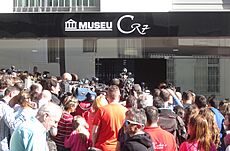
- Cristiano Ronaldo (born 1985), one of the most famous footballers in the world. He was born in Funchal and is the longtime captain of the Portugal national team.
- Artur de Sousa Pinga (1909–1963), a footballer and later coach.
- Marcos Freitas (born 1988), a European Champion table tennis player.
- Laura Luís (born 1992), a football forward for the Portugal women's team.
See also
 In Spanish: Funchal para niños
In Spanish: Funchal para niños



